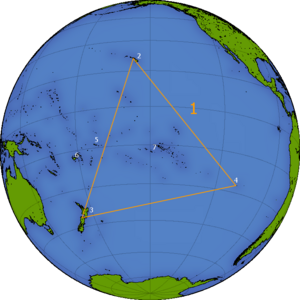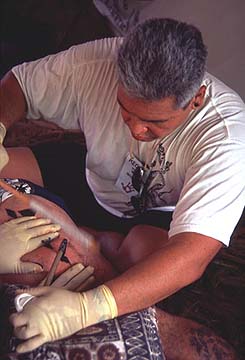Katzen and Kava: Difference between pages
(Page conversion via llm-mediawiki-rev -jwm) |
(Page conversion via llm-mediawiki-rev -jwm) |
||
| Line 1: | Line 1: | ||
[[File:Polynesia-triangle.png|thumb|right|(1)Polynesia, (2)Hawai'i, (3)New Zealand, (4)Easter Island, (5)Samoa, (6)Fiji, (7)Tahiti[https://en.wikipedia.org/wiki/Image:Polynesia-triangle.png][1]]] | |||
| | |||
| | |||
''' | '''Polynesia''' is part of the '''South Pacific''' typically defined as all the islands within in the triangle made by Hawai'i, [[New Zealand]], and [[Easter Island]], but also includes the island groups of Fiji and [[Samoa]]. Some other notable Polynesian islands are [[Tahiti]] and the French Polynesians (which contains the [[Marquesas Islands]]). | ||
Polynesia and the rest of the South Pacific is an important area in the history of tattooing. The rich and diverse tattoo heritage of the islands was one of the inspirations of James Cook, and other early explorers, to bring back the art of tattoo to Europe in the 17th century. | |||
== | == Contents == | ||
* [ | * 1 [[#Raiatea|Raiatea]] | ||
* 2 [[#Lapita|Lapita]] | |||
* 3 [[#Polynesian_Tattoo|Polynesian Tattoo]] | |||
* 3.1 [[#Tuhuna|Tuhuna]] | |||
* 3.2 [[#Kava|Kava]] | |||
* 4 [[#Polynesian_Islands_and_their_Tattoos|Polynesian Islands and their Tattoos]] | |||
* 5 [[#See_Also|See Also]] | |||
== Raiatea == | |||
Tradition has it that '''Raiatea''' is the cradle of Polynesian Civilization. In ancient times it was called Havai'i fanau'arefenu, meaning Havai'i the cradle of all lands. According to tales collected by Ethnologist Peter Buck, Tahiti and the little islands of the Windward group were created from an earth-fish that drifted from Havai'i in southwesterly direction, splitting itself along the way to become those islands existing today. | |||
== Lapita == | |||
'''Lapita''' is the early culture of the Polynesia. The culture is most often discussed in context of its pottery, which exhibit possible tattoo patterns of the early Polynesians like the [[Jomon]] of Japan. | |||
Lapita pottery bore incised decorations consisting of V-shaped elements, interlocking geometrical patterns, and stylized motifs resembling masks and sea creatures. Similar motifs are found in tattoo designs throughout Polynesia, and even the technique of incising the designs as a series of closely spaced punctures or stipples suggests that the technique used in the decoration of pottery was similar to that used in tattooing. | |||
It is believed the Lapita who arrived from Southeast Asia over 4,000 years ago started tattooing in Samoa and variations of it spread across the island groups of the South Pacific. By the 1820s, Europeans had nearly wiped it out completely. A resurgence of it started in the 1970s and is growing steadily. | |||
== Polynesian Tattoo == | |||
[[File:Tuhuna.jpg|right]] | |||
Tattooing was practiced in nearly all Pacific Island cultures. The origin may go back as far as the initial migration and colonization of the Pacific. Although tattooing is as old and widely distributed as any other Pacific decorative art, it has gone largely unrecognized as a fine art. In traditional Polynesian cultures, the tattoo flourished over any other means of body modification or decoration, including clothing. | |||
The following are some common aspects of Polynesian tattooing: | |||
=== Tuhuna === | |||
''Tuhuna'' is the traditional Polynesian term for a tattoo master. As in modern culture, an apprenticeship was also required to become a Tuhuna master tattooist. However, unlike Japanese or North American apprenticeships, to become a Tuhuna one had to learn the taboos that accompanied the craft. Once someone had acquired the necessary skills they became highly respected within the village and well known for his or her skill. | |||
=== Kava === | |||
''Kava'' is a slightly narcotic beverage that was served before tattooing ceremonies. In olden times it was distributed before going to war or attending religious ceremonies. It was also meant as a token of hospitality offered and accepted, thereby symbolizing alliance. | |||
== Polynesian Islands and their Tattoos == | |||
* New Zealand / [[Aotearoa]] | |||
* [[Kirituhi]] | |||
* [[Moko]] | |||
* [[Once Were Warriors]] | |||
* [[Samoa]] | |||
* [[Tahiti]] | |||
* [[Marquesas Islands]] | |||
* [[Easter Island]] | |||
== See Also == | |||
* [[Marshall Islands]] | |||
Category page: '''[[Category:Polynesian]]''' | |||
Latest revision as of 06:37, 17 September 2023

Polynesia is part of the South Pacific typically defined as all the islands within in the triangle made by Hawai'i, New Zealand, and Easter Island, but also includes the island groups of Fiji and Samoa. Some other notable Polynesian islands are Tahiti and the French Polynesians (which contains the Marquesas Islands).
Polynesia and the rest of the South Pacific is an important area in the history of tattooing. The rich and diverse tattoo heritage of the islands was one of the inspirations of James Cook, and other early explorers, to bring back the art of tattoo to Europe in the 17th century.
Contents
- 1 Raiatea
- 2 Lapita
- 3 Polynesian Tattoo
* 3.1 Tuhuna * 3.2 Kava
Raiatea
Tradition has it that Raiatea is the cradle of Polynesian Civilization. In ancient times it was called Havai'i fanau'arefenu, meaning Havai'i the cradle of all lands. According to tales collected by Ethnologist Peter Buck, Tahiti and the little islands of the Windward group were created from an earth-fish that drifted from Havai'i in southwesterly direction, splitting itself along the way to become those islands existing today.
Lapita
Lapita is the early culture of the Polynesia. The culture is most often discussed in context of its pottery, which exhibit possible tattoo patterns of the early Polynesians like the Jomon of Japan.
Lapita pottery bore incised decorations consisting of V-shaped elements, interlocking geometrical patterns, and stylized motifs resembling masks and sea creatures. Similar motifs are found in tattoo designs throughout Polynesia, and even the technique of incising the designs as a series of closely spaced punctures or stipples suggests that the technique used in the decoration of pottery was similar to that used in tattooing.
It is believed the Lapita who arrived from Southeast Asia over 4,000 years ago started tattooing in Samoa and variations of it spread across the island groups of the South Pacific. By the 1820s, Europeans had nearly wiped it out completely. A resurgence of it started in the 1970s and is growing steadily.
Polynesian Tattoo
Tattooing was practiced in nearly all Pacific Island cultures. The origin may go back as far as the initial migration and colonization of the Pacific. Although tattooing is as old and widely distributed as any other Pacific decorative art, it has gone largely unrecognized as a fine art. In traditional Polynesian cultures, the tattoo flourished over any other means of body modification or decoration, including clothing.
The following are some common aspects of Polynesian tattooing:
Tuhuna
Tuhuna is the traditional Polynesian term for a tattoo master. As in modern culture, an apprenticeship was also required to become a Tuhuna master tattooist. However, unlike Japanese or North American apprenticeships, to become a Tuhuna one had to learn the taboos that accompanied the craft. Once someone had acquired the necessary skills they became highly respected within the village and well known for his or her skill.
Kava
Kava is a slightly narcotic beverage that was served before tattooing ceremonies. In olden times it was distributed before going to war or attending religious ceremonies. It was also meant as a token of hospitality offered and accepted, thereby symbolizing alliance.
Polynesian Islands and their Tattoos
- New Zealand / Aotearoa
* Kirituhi * Moko * Once Were Warriors
See Also
Category page: '
